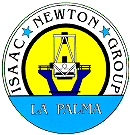|
Telephone:
+34 922 425400
Fax: +34 922 425401 Web: http://www.ing.iac.es/ |
 |
Apartado de Correos, 321
38700 Santa Cruz de La Palma Canary Islands; SPAIN |
|
Telephone:
+34 922 425400
Fax: +34 922 425401 Web: http://www.ing.iac.es/ |
 |
Apartado de Correos, 321
38700 Santa Cruz de La Palma Canary Islands; SPAIN |
|
The Isaac Newton Group of Telescopes is an establishment of the Particle Physics and Astronomy Research Council of the United Kingdom and the Nederlandse Organisatie voor Wetenschappelijk Onderzoek of the Netherlands. |
|
|
| Press Release ING 3/2000
Date: Friday 4 August 2000 Embargo: For immediate release COMET LINEAR: GOING, GOING... BUT NOT QUITE GONE!
Continuous monitoring of Comet LINEAR by the Jacobus Kapteyn Telescope
showed that it was disintegrating as it approached the Sun. The latest and
best images from the larger aperture Isaac Newton Telescope now give us the
clearest idea so far of how and why the comet disintegrated.
Having previously appeared completely normal, on the night of July 25th the
comet was seen to undergo a rapid change. The initially compact comet
nucleus evolved into a fuzzy, extended and much fainter object. This caused
much speculation as to what the reason for the disruption of the comet might
be. Further observations with the telescopes of the Isaac Newton Group at
the Roque de los Muchachos Observatory, La Palma, Spain as well as
telescopes elsewhere have confirmed the initial discovery and provided new
insight into what the reason for the comet disruption could be: the
evaporation of all the ice in the nucleus.
Cometary nuclei are a mixture of solid lumps of material of various sizes,
held together by a cement of ices. When comets pass close to the Sun during
their journey across the solar system the icy elements (mainly water ice and
carbon monoxide ice) sublime, leaving loose material behind that forms the
dust tail of the comet, while the sublimed ice forms its gas tails. As a
result of this process, or due to the strong gravitational pull from a
planet such as Jupiter, or from the Sun, a comet nucleus may sometimes split
into two or more fragments. What was seen in the case of Comet LINEAR,
however, was different.
From analysis of the images that lay out the recent sequence of events for
Comet LINEAR, Dr. Mark Kidger from the Spanish Instituto de Astrofísica de
Canarias concludes that this small comet probably ran out of ice altogether,
leaving behind a loose conglomerate of particles that are now gradually
dispersing into space. This model fits the observations well, as
measurements have shown that the activity of the comet had been declining
for several weeks as ice gradually sublimed away. During the comet's closest
approach to the Sun, a burst of activity was recorded. Then, when all the
ice was exhausted and nothing was holding together the solids, the nucleus
began to fall apart.
The latest images taken with the 2.5 metre Isaac Newton Telescope after
break-up show no sign of the comet's original nucleus, nor of any active
sub-nuclei larger than a few metres across. Any large remnants of the
nucleus that remain cannot be subliming significantly or they would have
been detected in these images. This corroborates the sequence of events
proposed by Dr. Kidger. Other comets are known to have disappeared, but
Comet LINEAR is the first one to have been caught in the act.
Comet LINEAR has maybe not been a spectacular night-time sight for most
people, but for astronomers it presents an important and unique event of
what can be described as the death of a comet.
The Isaac Newton Group of telescopes (ING) is an establishment of the
Particle Physics and Astronomy Research Council (PPARC) of the United
Kingdom and the Nederlandse Organisatie voor Wetenschappelijk Onderzoek
(NWO) of the Netherlands. The ING operates the 4.2 metre William Herschel
Telescope, the 2.5 metre Isaac Newton Telescope, and the 1.0 metre Jacobus
Kapteyn Telescope. The telescopes are located in the Spanish Observatorio
del Roque de Los Muchachos on La Palma which is operated by the Instituto de
Astrofísica de Canarias (IAC).
PICTURES
Picture credit: Dr. Mark Kidger, Instituto de Astrofísica de
Canarias.
Available formats:
Picture credit: Dr. Mark Kidger, Instituto de Astrofísica de
Canarias.
Available formats:
Picture credit: Nik Szymanek and Ian King.
Available formats:
FOR FURTHER INFORMATION PLEASE CONTACT:
Dr. Mark Kidger
Mr. Javier Méndez
More information on ING:
http://www.ing.iac.es/PR/
More information on this news can be found in IAU circular 7472.
Other web sites:
Mark Kidger's comet web pages: http://www.iac.es/galeria/mrk/ |